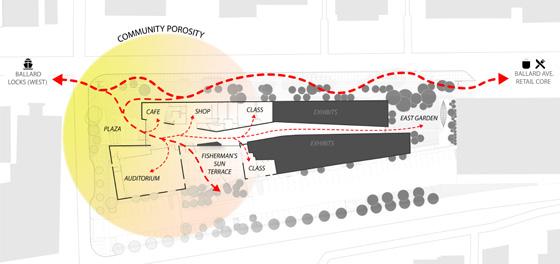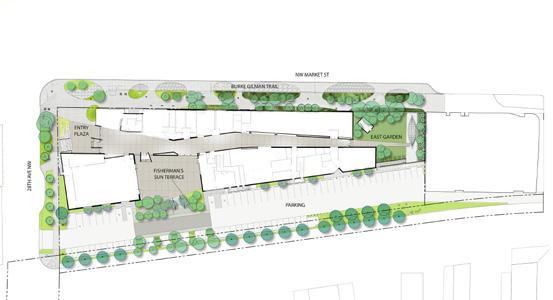
6 minute read
Landscapes that Welcome
Mithun shares the secrets and symbolism that inspired the Museum’s open spaces
by Dakota Keene, ASLA, LEED AP BD+C
Aligned with the National Nordic Museum’s goal to serve as a community gathering space, the plazas and gardens of the Museum invite neighbors and visitors to linger in both the indoor and outdoor common areas, and these are intentionally located prior to the ticketed exhibit areas. This open access ensures that everyone will feel welcomed and inspired by their experience, even if they just want to visit Freya for fika (a coffee break) and take their refreshments across to the Fisherman’s Sun Terrace to watch the working waterfront in action.
Recently at the American Institute of Architects Seattle Chapter Awards Ceremony, where the National Nordic Museum received the Honor Award, juror Bryan C. Lee Jr. of Colloqate in New Orleans underlined this idea when he said that the designers “foregrounded community space” by intentionally situating public amenities front and center. This is not a place you visit once and check the box; the National Nordic Museum offers incredible programming—cutting edge music performances, traditional craft making, films, and more—and serves as an engaging community amenity that visitors and Members return to over and over again. The open community spaces around the Museum are an essential offering that create a framework of multi-benefit gathering for everyone in the Ballard neighborhood and beyond.
The Entry Plaza was designed as an extension of the Fjord Hall, as if the water of the fjord has spilled out of the Museum doors and begins to meet the open seas beyond. Realized as a flexible gathering space, the public realm blurs from the sidewalk to the plaza, subtly shifting in paving pattern and serving as a ceremonial terrace for events like the Museum’s 2018 ribbon-cutting with Iceland President Guðni Thorlacius Jóhannesson and Her Royal Highness Mary the Crown Princess of Denmark.
The Fisherman’s Sun Terrace, with its celebratory festoon lighting, is located outside of the Osberg Great Hall. Glass folding doors seamlessly blend between interior and exterior, accommodating events and flexible “spillout” from the classrooms and the auditorium.
The only garden in the ticketed zone, the East Garden serves to provide a quiet moment with its simple configuration and private plant screenings, aimed to create a sense of respite and contemplation.

CONNECTION TO NATURE AND CULTURE
Connection to nature is a value inextricably linked to Nordic culture and is also widely valued by Pacific Northwesterners. The Museum’s design team was inspired by the concept of friluftsliv (free-loofts-liv) which translates as “open-air living”—a concept purported by the Norwegian playwright and poet Henrik Ibsen to describe the value of spending time in the natural world to support a restorative experience of mind and body. At the National Nordic Museum, opportunities abound to connect with nature by enjoying the East Garden’s sauna or sitting under a grove of trees with a bed of ferns at your feet. This marrying of the indoor and outdoor spaces of the Museum was an essential guiding element to the landscape design.
The streetscape along Market Street in front of the Museum, which was hidden behind SDOT’s orange barriers for much of the summer of 2019, features undulating shapes in the ground plane, evoking the Nordic/ Northwest archipelago landform and the playful geometries of iconic Nordic textile design. As visitors walk from east to west along the sidewalk, they traverse a gradient of the bioregions of the Nordic countries. Experienced from the east edge, the landscape is planted to harken the shady, lush forests of the northern climes, while the west approach to the front door of the Museum at the Entry Plaza is bordered by open meadows with nodding seed heads of grasses and airy wildflowers that greet visitors with a sunny, open environment.
An important aspect of Nordic culture, the fishing industry and working waterfront is on full display from the Fisherman’s Sun Terrace. Here the design evokes geologic landforms along fjords such as Pulpit Rock in Norway. Visitors are invited to walk a circuitous path through the grove of multi-stem birch trees, symbolizing the journey through the forested hillsides of many areas of the Nordic countries.
The simple meadow lawn of the East Garden was inspired by consulting architect Juhani Pallasmaa, who requested that it feel like his “father’s horse pasture” and features a picturestone, a replica Viking ship, and one of the oldest working saunas in the US. This garden is bordered by coniferous trees, evocative of the Nordic forests, and under-planted with edible berries often used in Nordic cuisine, such as lingonberry (Vaccinium vitis-idaea) and huckleberry (Vaccinium ovatum). During springtime, visitors may catch a glimpse of twinflower (Linnea borealis), a shy native plant of the Pacific Northwest and also the unofficial national flower of Sweden. Perennials border the garden, including a row of astrantia flowers (Astrantia major Star of Royals) that peek out from behind the runestone. Astrantia flowers are rumored to grace Karen Blixen’s historic garden outside of Copenhagen and, as some stories claim, these regal and intricate starbursts may have made it into her unusual floral arrangements.
Reflecting the innovative, sustainable strategies of Nordic countries and with sensitivity to our regional watersheds, the site’s stormwater runoff is filtered by bioretention cells that are planted with vibrant Northwest native trees and plants, and modular wetland treatment systems after passing through the pervious surfaces of the parking lot.


INTERSECTION OF HISTORY AND HIPSTERS
As Executive Director Eric Nelson mentioned in his remarks at the Museum’s opening ceremony in 2018, “Our front doors open to shops and restaurants, our back door to the working waterfront. The Museum stands at the intersection of history and hipsters.” The National Nordic Museum bridges the previously disjointed areas of Ballard and creates an open and thriving destination that seeks to welcome all.
The bold archipelago shapes and textile patterns of the planting beds and paving along Market Street were designed to create a new, generous thirty-threefoot-wide sidewalk and shared-use trail experience. This civic improvement claims the street right-of-way for pedestrians, and further connects Ballard’s retail core with the Museum and beloved public open spaces at the Ballard (Hiram Chittenden) Locks, Shilshole Bay Marina, and Golden Gardens to the west.
In 2019, the National Nordic Museum received several prestigious accolades, including:
Seattle Business Magazine Skyline Awards, Gold Award / Cultural Development of the Year
American Institute of Architects (AIA) Northwest and Pacific Region Design Award, Merit Award
AIA Seattle Honor Awards for Washington Architecture, Award of Honor
Mid-Atlantic Association of Museums Buildy Award
US Green Building Council Leadership in Energy and Environmental Design (LEED) Gold Certification
For his role in leading the change from Nordic Heritage Museum to National Nordic Museum, Eric Nelson was named the Swedish-American of the Year by the Vasa Order and was Knighted the Order of the White Rose of Finland by the Finnish president.
At the beginning of 2020, the National Nordic Museum was nominated by USA Today travel writers for a Readers’ Choice Award as one of the 10 Best New Museums of 2020

